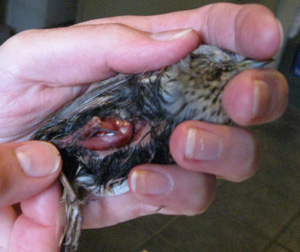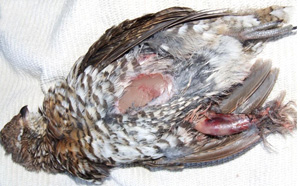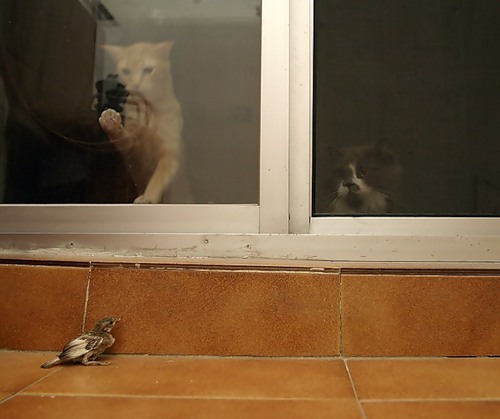


Cats are wonderful animals. As youngsters, they are cute as can be. Watching them frolic is pure pleasure; playing with them is even more fun. As adults, their interactions with us are complex; we find gratification in their use of us as means to comfort. We admire them in their arrogance; we even laud them for it — look at the cartoon cats that capture their place in our culture.
I confess it: When taking an injured bird up to The Wild Bird Fund for more advanced diagnostics or treatment than I can deliver as a solo wildlife rehabilitator, part of the pleasure is visiting with the cats who live in the veterinary practice as resident blood-donors. I am not among those so charmed by cats that I would welcome them into my household; litterbox-cleanup is not some something I contemplate with joy. But I do like other-peoples' cats and will cheerfully spend a visit playing with them over attentive conversation with my host.
But let's be philosophical for a moment: Having animals as companions is a matter of caring in very special ways about what is going on in the constellation of events that makes our worlds. It is caring for the well-being of the animals, certainly, and that includes caring for the well-being of of the household in which it lives, and of those whose worlds touch ours and so on. We're often not as good at it as we should be (there is a mea culpa in that), but we are obliged to try. I have the sense that more “cat owners” (if that is not a contradiction) are less able in this caring than they should be; one is inclined to suspect an unwillingness to face the responsibilities of having cats (it always seems to be more than one) as companions.
In short, cats present problems.
Some cat-problems mainly have to do with cats outdoors — feral cat populations and home-kitties allowed outdoor time, even on city balconies.
Cats hunt “for pleasure”. Feral cats regularly fed to repletion by local cat-ladies still go a-huntin'. A well-fed house cat allowed out will go a-huntin'. Among favorite prey: Birds. Song birds — the kind now almost altogether gone from lower Manhattan (when did you last hear a variety of birdsong in Washington Market Park?). A recent study conducted by staff at the Smithsonian Conservation Biology Institute documented nearly 80 percent losses of avian juveniles — nestlings and recently fledged (therefore, relatively helpless, unable to fly away, &c.) — in the studied population, in urban and suburban areas, from cat predation.
This is what cat-hunting looks like:
|
|
|
|
Pay careful attention to these pictures. The first and second are important because they show the cat killed the bird but did not eat it. The birds were ripped open — played with — and left to die. The third picture is particularly poignant: That bird is a fledgling, just out of its nest and not able to fly well. It could make it to a landing place, but if attacked, it would not be able to take flight in its own defense. It's still just a baby.
Sometimes, the bird that is attacked by a cat does get away. It is injured — scratched, or perhaps bitten. It is condemned to a horrible lingering death from infection. That death is inevitable.
Cat claws carry bacteria, particularly two strains of Bartonella bacteria — see below. If you are scratched, you get a red inflamed area around the scratch. If a bird is scratched, it will soon die. Cat saliva is laced with Pasteurella and other bacteria; this can be a problem (usually minor) for us. In a small bird's system, even with prompt antibiotic treatment, it is almost always fatal.
Cats kill birds — and other wild animals. They are not “clean killers”. They hunt, wound and frequently leave the animal alive and dying; they do not play nicely. They do this for the pure joy of it; it is part of what being-a-cat is. I've heard variants on the following from more than one experienced wildlife rehabilitator: “It's spring. I get to tell lots of children that the reason those little baby bunnies are clawed up and unlikely to survive is that their neighbors are letting kitty out again.”
There is a whole class of diseases that can be transmitted from animals to people. The correct term for such diseases is “zoonotic”. I am very much aware of these things; there are things I do that require me to be be cognizant of zoonoses and public health issues.
Cats are a primary source of zoonotic diseases. Two of these diseases — or rather, their causes — have been gaining more attention over the last several years. They are scary, far more so than what people think they might get from squirrels and pigeons and so on. Kitty, after all, may be living right in your home — or next door.
Toxoplasmosis
Toxoplasmosis is an infection by a little bug, a protozoan called T. gondii. Kitty is its “definitive host”; this bug can only reproduce sexually when it is living in a cat. Kitty goes poo, and T. gondii eggs (the fancy word is “oocyst”) enter the Wider World. The eggs get eaten and start moving up the food chain. Mommy (or here in Tribeca, maybe nanny...) cleans the litterbox and the little bug gets picked that way.
The active infection is usually nothing scary. In people, it's on the order of a mild case of flu, and is not considered serious except for immune-system compromised people (small children, one assumes, as well as people with various diseases or taking various suppressing medications). The Standard Line has been toxoplasmosis is not a Big Deal, for this reason.
After the initial active infection with clinical signs your doctor may recognize, T. gondii tucks itself into a tough little pocket (a cyst) and sets about trying to get home to kitty. This is a latent toxoplasmosis infection and in people, it is generally not discovered (no overt clinical signs) and it is lifelong.
Ultimately, T. gondii wants to get back in a kitty; that's where it can have fun Fun FUN (a/k/a sex). So, it takes steps, so the story goes, to make its new, non-feline hosts more cat-oriented. For example, most small rodents smell cat scat and pee and go the other way; it seems small rodents with latent T. gondii infection behave differently. They will remain in the area and even find kitty interesting. Kitty can catch this critter easily and maybe the bug gets home for some whoopee.
Clearly, T. gondii is messing with the brain of the critter. The rather involved reports (see ...Toxoplasmosis/Schizophrenia Research... for an example and further reading...) suggest T. gondii slips a couple substances into the system that in turn result in increased dopamine levels.
This is the nasty part: The same thing happens in us. There is increasing evidence that latent toxoplasmosis is commonplace. Infected people may, like infected mice, end up producing more than their normal share of dopamine. High levels of dopamine are associated with the package of symptoms covered by that catchall darling of the psychiatric world, schizophrenia. There is good evidence that toxoplasmosis in a pregnant woman can lead to serious birth defects, especially retardation, in baby.
It gets more complex. Rh- people tend to be more alert and responsive to changing circumstance than Rh+ people. But: Rh- people who have a latent T. gondii infection are less alert and responsive — e.g., are more likely to have traffic accidents (reported by J. Flegr in various places; replicated results reported in several journals). About 12-15 percent of the general EuroAmerican population is Rh-, depending on whose paper you read.
“O, but I don't have that.” Well, maybe. Recent evidence suggests latent toxoplasmosis is more widely spread in human populations than hitherto believed. Part of the problem seems to be the mildness of the active infection, so that many people end up with the latent infection and it is not recognized, or even considered in the event of, well, problems.... While some of the research goes back to the 1970s, a great deal of the best science is very recent — less than a decade old. One reliable report, cited by a friend in lectures prepared for delivery at Cornell University, suggests evidence of infection in 12 to 15 percent of the U. S. population; in our part of the country, the number is more like 30 percent. Recent research suggests that these numbers for latent T. gondii infection are extremely conservative.
Is this the origin of “cat ladies”? That is too simple, certainly. There are other elements at work — hoarding plays a role, as does genuine concern. But — well, some cat-loving neighbors really do seem a bit around the bend and the neurological effects of toxoplasmosis seem altogether too neat a fit to be just coincidental.
[How crazy can it get? One is tempted to think of the strange behavior associated with cat-ladies (of both sexes), though reliable science has not yet drawn definite conclusions. I have wondered about the cat-lady guy who lives upstairs from me. Does he have a latent T. gondii infection? Not known — but one is inclined to speculate. When damage to his pipes was causing flooding in my apartment, building maintenance staff said he would not admit them to fix the leak (we had to get city inspectors to order the fix). Is he delusional? Well, he keeps saying that pigeons on my balcony are pooping on his balcony; this entails believing in a suspension of the laws of physics (pigeons two places at one time or poop flying upward rather than dropping down). His anti-social behavior includes going about the building disturbing all the neighbors as he rants on at Mrs. Jenner. I note in passing, he was crazy enough to blow his career away; he was compelled to resign from the bar “for disciplinary reasons”.]
Bartonellosis
This came up before; cats host Bartonella henselæ and Bartonella clarridgeiæ. B. henselæ and B. clarridgiæ are part of a family of bugs that's been killing people for a long time. These particular species have been generally considered to be a very small problem, if that. Some recent conversations suggest that this infection — cat scratch fever — is no longer being treated so casually. One vet-cum-epidemiologist (impressive; two doctorates and a lot of really interesting published science) even went so far as to suggest that bartonellosis might prove a greater zoonotic threat than toxoplasmosis. Here's a summary of the science behind this view: Bartonellosis-SelectedPapers.pdf
Most of us have experienced a cat-scratch; the area around it is reddened and sore and maybe we treat it with a topical antibiotic or some kind of antiseptic, and perhaps even some liquid bandage. It's not a big deal.
[I note in passing, I have had pigeon-talon scratches that don't redden and don't last as long and do nicely with a quick wash-up — and pigeons have really dirty toenails; you'd think the scratches would be at least as nasty as those from cat-talons. It's not generally so.]
Cat-scratch fever as it is described in various places appears to be a sort of complication arising from the initial infection. It takes some time to show up — a week or two, depending on whose book you read. The symptoms are local to the point of infection — some swelling of the lymph nodes, perhaps a raised, reddened or purplish mass sort of like a pimple in the formative stage, perhaps symptoms not unlike that of flu or a cold. Most often, the whole thing goes away on its own with few obvious lingering problems. Things can be more involved in people with immune-system problems — children, people with some kinds of chronic disease and I imagine, people with some kinds of allergies, which seem to arise from immune system sensitivity.
That's typical cat-scratch fever. There are atypical forms, and these are gaining increasing attention as perhaps not all that uncommon after all. The initial infection can become quite severe and the causes elusive. For example, some instances of aseptic meningitis have been traced back to B. henselæ infection.
The problem with all this is that it's still new thinking. The data are suggestive, but not conclusive, and it takes time for new ideas to gather consensus. It should, however, give one pause.
Kitty can make you sick. The result is not good for you, and it deprives your companion of the care it is entitled to, as a compensation for giving up its independence. If you are not well in body and in mind, you cannot be your cat's loving, caring companion.
This is not a call to Give Up Kitty. Putting everything else aside, it's not fair to the cat. It might also not be fair to the person who keeps kitty company and loves kitty. Most especially, many people who have cats as companions are truly loving and responsible. They love their cats and do all that can be done to keep them hale. The cats in such companionable relationships are wonderful to be with, both for their regular companions and occasional guests.
This is a call to keep Kitty in the house. It's not good for your house cat to be outside. Your cat is not well adapted to anything in the city if it's been a house cat.
Keep Kitty away from other cats. Cat-to-cat disease transmission is a concern, and one can not really be sure other cats have had appropriate precautions taken against disease-vector parasites. Have Kitty checked for various bugs. While you're at it, have your physician check for evidence of cat-borne diseases you may have picked up and continue to carry in a latent form, then deal with them if they are present.
Clearly, feral cats are a tremendous problem. For whatever reason, misguided souls — cat-ladies of both sexes, who translate the usual hoarding-at-home behavior into cat-colony-care — support these populations. Feral cats are fed. Feral cats are taken in — trapped. Their litters are “socialized” and then placed in homes. Adults are neutered, then released if they cannot be socialized.. This is a very bad idea, however politically attractive to, e. g., humane societies. Here is how one humane society describes its position:
|
Responsible management of existing feral cat colonies should include: humane trapping, sterilization, rabies vaccination, and treatment for illness or injury; removal of kittens and friendly adults for possible placement in homes; euthanasia of animals whose suffering cannot be alleviated; ear-tipping and returning ferals to the same location where they were trapped provided they would not face imminent risks; and providing lifelong care consisting of adequate food, water, and shelter as well as regular monitoring of the colony for sickness, injury, and the arrival of new animals. The goal of any feral cat management program should be to maximize quality of life for the cats and to eliminate the existing colony over time through attrition. Humane
Society of the United States,
http://www.humanesociety.org/ |
First, and most obviously, those cats and kittens retrieved and socialized must be assumed to carry all the bugs mentioned earlier. Bring them into a house with other cats or into contact with neighboring cats otherwise not infected, and one must assume the other cats will become infected.
One must also deal with the likelihood that people in the household are going to be exposed and will quite probably contract more involved cat-borne diseases than would be true of cats without that feral background. If the receiving household is that of a young family, or includes young women who may eventually wish to have children, the problem is acute.
The idea of putting kitty back in its now-”sanitized” colony, then sustaining that colony, is the most wrongheaded part of this program. Feral cats kill other animals. They kill birds. They kill small mammals. They kill endangered species. They will do this regardless of being well-fed.
Clearly, there is no good solution to the problem of feral cats; there is certainly no politically easy solution. The cat-ladies of both sexes who derive special pleasure from their concern and care for feral cats are vocal and politics is about greasing squeaky wheels. Arguably, the animal-hoarding propensity that is, as it seems, often thus sublimated is less obviously harmful to cats than the more usual cases — dozens of cats ill-kept and ill-treated in a small house or apartment.
On the other hand, Putting these cats back into circulation, with the idea that “attrition” will solve the problem simply ignores the reality of new cats entering the the feral population through abandonment, &c.. The most favorable success-rate reports — from pro-cat lobbyists who implement such programs, hardly neutral — make clear that feral cat populations do not decline. The evidence appears to be that newly abandoned cats as well as already-feral cats escaping the trapping process continue to breed. This is, in fact, consistent with data from other feral populations. It may well be inherent in the establishment of an ecological niche, that short of a dramatic alteration of circumstances, a general population equilibrium is to be expected.
[It is interesting to note that other feral populations are relatively stable. In our area, e. g., the pigeon population is stable, or just slightly declining, at a rate of -0.25 percent or perhaps a bit faster. See http://www.mbr-pwrc.usgs.gov/bbs/htm03/trn2003/tr03131.htm. This makes an increase in feral cat and feral dog populations a greater concern since it is atypical.]
Since some of our cat-loving neighbors are not responsible, it is incumbent on the rest of us to see that the problems this lack entails are contained.